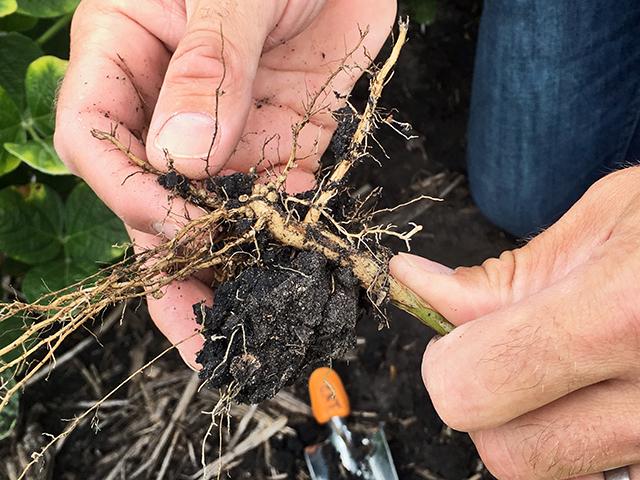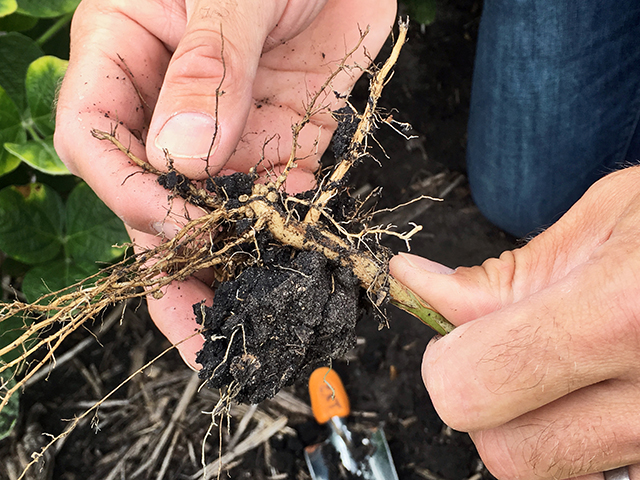Production Blog
Bt Trait Waits in the Wings as Soybean Farmers Struggle with SCN Control
ROCKVILLE, Md. (DTN) -- It's well understood that farmers need more options for control of soybean cyst nematode (SCN), the tiny root parasite that steals more than a billion dollars from soybean growers every year.
That's why the scarcity of new SCN-resistant soybeans is frustrating for farmers like Aimee Bissell, a Bedford, Iowa, farmer who told DTN about her fruitless searches each year for a Peking soybean variety to grow. She wants to battle nematodes that have evolved resistance to the more common type of SCN-resistance, PI 88788, but market and industry forces have kept alternative resistance sources stalled. (See the full story here: https://www.dtnpf.com/…)
Jonathan Fischer, a regional strategic marketing lead for BASF, has a message for growers like Bissell: Hang on a little longer!
The company is currently moving a novel Bt soybean trait through the U.S. regulatory system, with a goal of bringing it to market by the end of this decade.
The trait, GMB151, may make a little history. It's poised to be the first Bt soybean on the U.S. market, while also being the first Bt protein, Cry14Ab-1, to target SCN, which has been managed by native resistance genes and seed treatments for the past three decades.
P[L1] D[0x0] M[300x250] OOP[F] ADUNIT[] T[]
More importantly, Fischer said the company hopes it will let soybean farmers do something that has evaded them for decades: manage SCN sustainably with multiple modes of action, each season.
The goal is to add the Bt trait to soybean varieties with native resistance genes, such as Peking or PI 88788, and recommend a seed treatment that targets SCN, Fisher said. "That's the concept we'd like to go forward with for the most sustainable solution to SCN," he said. "Because if we don't do that, and we only go with this one solution in isolation, that's only going to put more pressure on the trait, selecting for resistance."
The SCN trait is currently classified by EPA as providing "moderate suppression" of SCN, meaning it doesn't kill every nematode that encounters it. But Fischer said company field trials suggest it will provide a yield benefit sizeable enough to offset any tech fees that come with it. "We're certainly mindful of the return on investment that we need to demonstrate for the grower," he said.
Moderate control of SCN, combined with the nematodes' limited ability to feed and mate beyond a small section of soil each season, means the trait is unlikely to come with a refuge requirement, Fischer added. A full resistance management plan will be in place, however, when the trait finally gains a Section 3 registration from EPA, which BASF expects by the end of 2022, he said.
USDA signed off on GMB151 in March, granting it fully deregulated status. But other regulatory hurdles lie ahead, namely, gaining import approvals for the trait from major soybean trading partners such as China, Japan and the EU, he added.
Planning for a late-decade launch is a tricky path for soybean breeders, who know the trait is destined for germplasm that isn't on the market yet, particularly with the fast-moving turnover in herbicide-tolerant trait technology.
But here, the single-gene Bt trait provides a significant advantage over native resistance traits, like Peking, which often involve multiple genes, Fischer noted. Moving the Bt trait between germplasm is a simpler affair and, so far, BASF breeders haven't found any concerning genetic baggage with the trait, such as yield drag, he said. "We're still continuing to test it in new, diverse backgrounds, so it's not to say it's a guarantee we won't see something down the road; but as of today, nothing has caused any issues in that respect," Fischer said.
Read more about GMB151 from DTN here: https://www.dtnpf.com/… and from EPA's regulatory docket here: https://www.regulations.gov/….
Emily Unglesbee can be reached at Emily.unglesbee@dtn.com
Follow her on Twitter @Emily_Unglesbee
(c) Copyright 2022 DTN, LLC. All rights reserved.






Comments
To comment, please Log In or Join our Community .